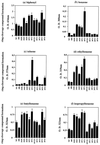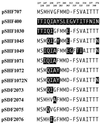Directed evolution of biphenyl dioxygenase: emergence of enhanced degradation capacity for benzene, toluene, and alkylbenzenes
- PMID: 11514531
- PMCID: PMC95430
- DOI: 10.1128/JB.183.18.5441-5444.2001
Directed evolution of biphenyl dioxygenase: emergence of enhanced degradation capacity for benzene, toluene, and alkylbenzenes
Abstract
Biphenyl dioxygenase (Bph Dox) catalyzes the initial oxygenation of biphenyl and related compounds. Bph Dox is a multicomponent enzyme in which a large subunit (encoded by the bphA1 gene) is significantly responsible for substrate specificity. By using the process of DNA shuffling of bphA1 of Pseudomonas pseudoalcaligenes KF707 and Burkholderia cepacia LB400, a number of evolved Bph Dox enzymes were created. Among them, an Escherichia coli clone expressing chimeric Bph Dox exhibited extremely enhanced benzene-, toluene-, and alkylbenzene-degrading abilities. In this evolved BphA1, four amino acids (H255Q, V258I, G268A, and F277Y) were changed from the KF707 enzyme to those of the LB400 enzyme. Subsequent site-directed mutagenesis allowed us to determine the amino acids responsible for the degradation of monocyclic aromatic hydrocarbons.
Figures



Similar articles
-
Enhanced degradation of polychlorinated biphenyls by directed evolution of biphenyl dioxygenase.Nat Biotechnol. 1998 Jul;16(7):663-6. doi: 10.1038/nbt0798-663. Nat Biotechnol. 1998. PMID: 9661201
-
Steady-state kinetic characterization of evolved biphenyl dioxygenase, which acquired novel degradation ability for benzene and toluene.Biosci Biotechnol Biochem. 2006 Apr;70(4):1021-5. doi: 10.1271/bbb.70.1021. Biosci Biotechnol Biochem. 2006. PMID: 16636475
-
Active-site engineering of biphenyl dioxygenase: effect of substituted amino acids on substrate specificity and regiospecificity.Appl Microbiol Biotechnol. 2006 Jun;71(2):168-76. doi: 10.1007/s00253-005-0135-2. Epub 2005 Oct 11. Appl Microbiol Biotechnol. 2006. PMID: 16217654
-
Construction of hybrid biphenyl (bph) and toluene (tod) genes for functional analysis of aromatic ring dioxygenases.Gene. 1994 Jan 28;138(1-2):27-33. doi: 10.1016/0378-1119(94)90779-x. Gene. 1994. PMID: 8125315
-
Functional analyses of a variety of chimeric dioxygenases constructed from two biphenyl dioxygenases that are similar structurally but different functionally.J Bacteriol. 1997 Jun;179(12):3936-43. doi: 10.1128/jb.179.12.3936-3943.1997. J Bacteriol. 1997. PMID: 9190809 Free PMC article.
Cited by
-
Epoxide formation on the aromatic B ring of flavanone by biphenyl dioxygenase of Pseudomonas pseudoalcaligenes KF707.Appl Environ Microbiol. 2005 Sep;71(9):5354-61. doi: 10.1128/AEM.71.9.5354-5361.2005. Appl Environ Microbiol. 2005. PMID: 16151125 Free PMC article.
-
Assessment of toluene/biphenyl dioxygenase gene diversity in benzene-polluted soils: links between benzene biodegradation and genes similar to those encoding isopropylbenzene dioxygenases.Appl Environ Microbiol. 2006 May;72(5):3504-14. doi: 10.1128/AEM.72.5.3504-3514.2006. Appl Environ Microbiol. 2006. PMID: 16672497 Free PMC article.
-
Microbial enzymes: tools for biotechnological processes.Biomolecules. 2014 Jan 16;4(1):117-39. doi: 10.3390/biom4010117. Biomolecules. 2014. PMID: 24970208 Free PMC article. Review.
-
Structural Basis of the Enhanced Pollutant-Degrading Capabilities of an Engineered Biphenyl Dioxygenase.J Bacteriol. 2016 Apr 28;198(10):1499-512. doi: 10.1128/JB.00952-15. Print 2016 May 15. J Bacteriol. 2016. PMID: 26953337 Free PMC article.
-
Crystal structure of the terminal oxygenase component of cumene dioxygenase from Pseudomonas fluorescens IP01.J Bacteriol. 2005 Apr;187(7):2483-90. doi: 10.1128/JB.187.7.2483-2490.2005. J Bacteriol. 2005. PMID: 15774891 Free PMC article.
References
-
- Batie C J, Ballou D P, Correll C J. Phthalate dioxygenase reductase and related flavin-iron-sulfur containing electron transferases. In: Muller F, editor. Chemistry and biochemistry of flavoenzymes. Boca Raton, Fla: CRC Press, Inc.; 1991. pp. 544–554.
-
- Cho M C, Kang D-O, Yoon B D, Lee K. Toluene degradation pathway from Pseudomonas putida F1: substrate specificity and gene induction by 1-substituted benzenes. J Ind Microbiol Biotechnol. 2000;25:163–170.
-
- Ensley B D, Ratzkin B J, Ossulund T D, Simon M J, Wackett L P, Gibson D T. Expression of naphthalene oxidation genes in Escherichia coli results in the biosynthesis of indigo. Science. 1983;22:167–169. - PubMed
MeSH terms
Substances
LinkOut - more resources
Full Text Sources

